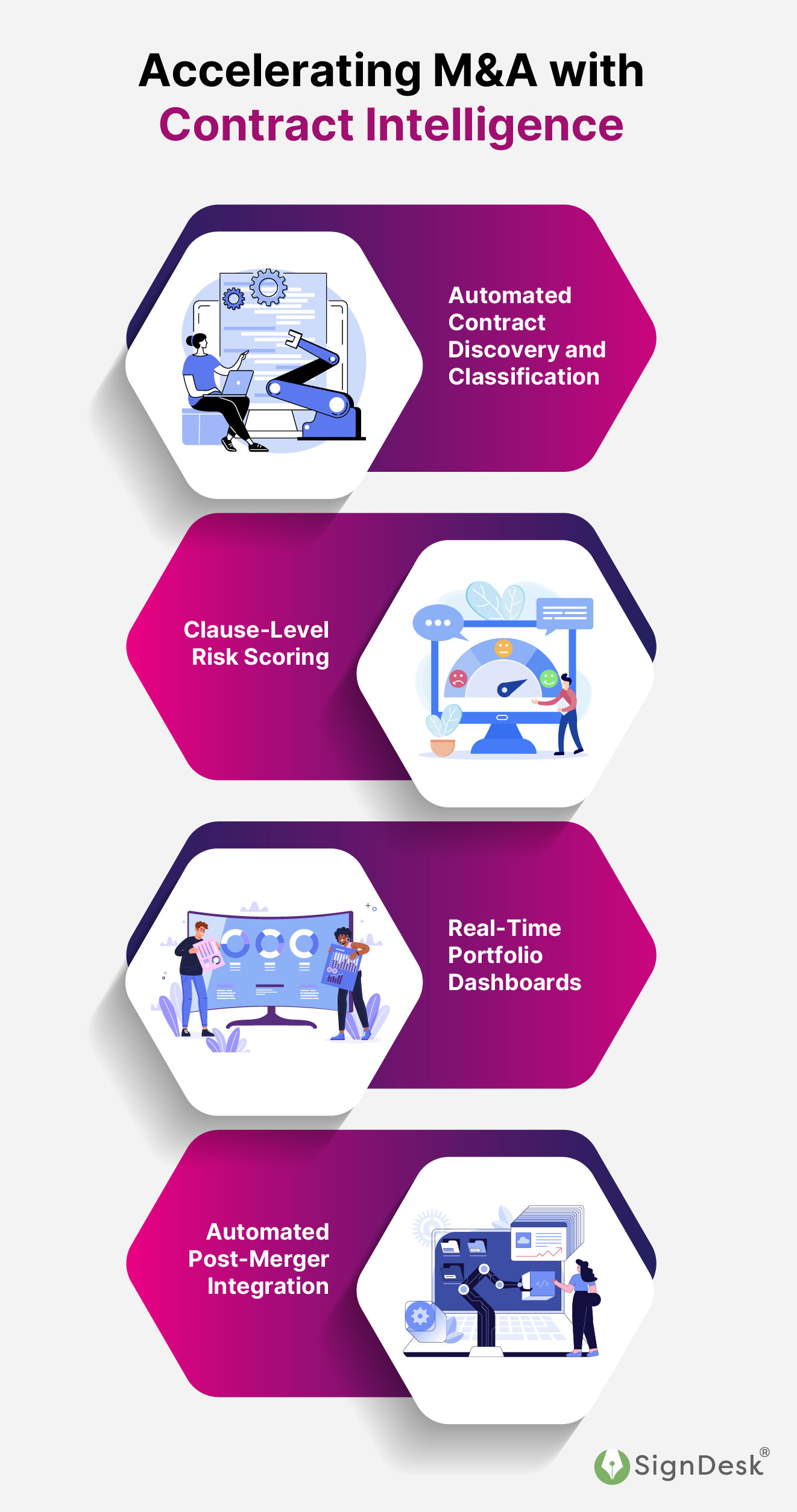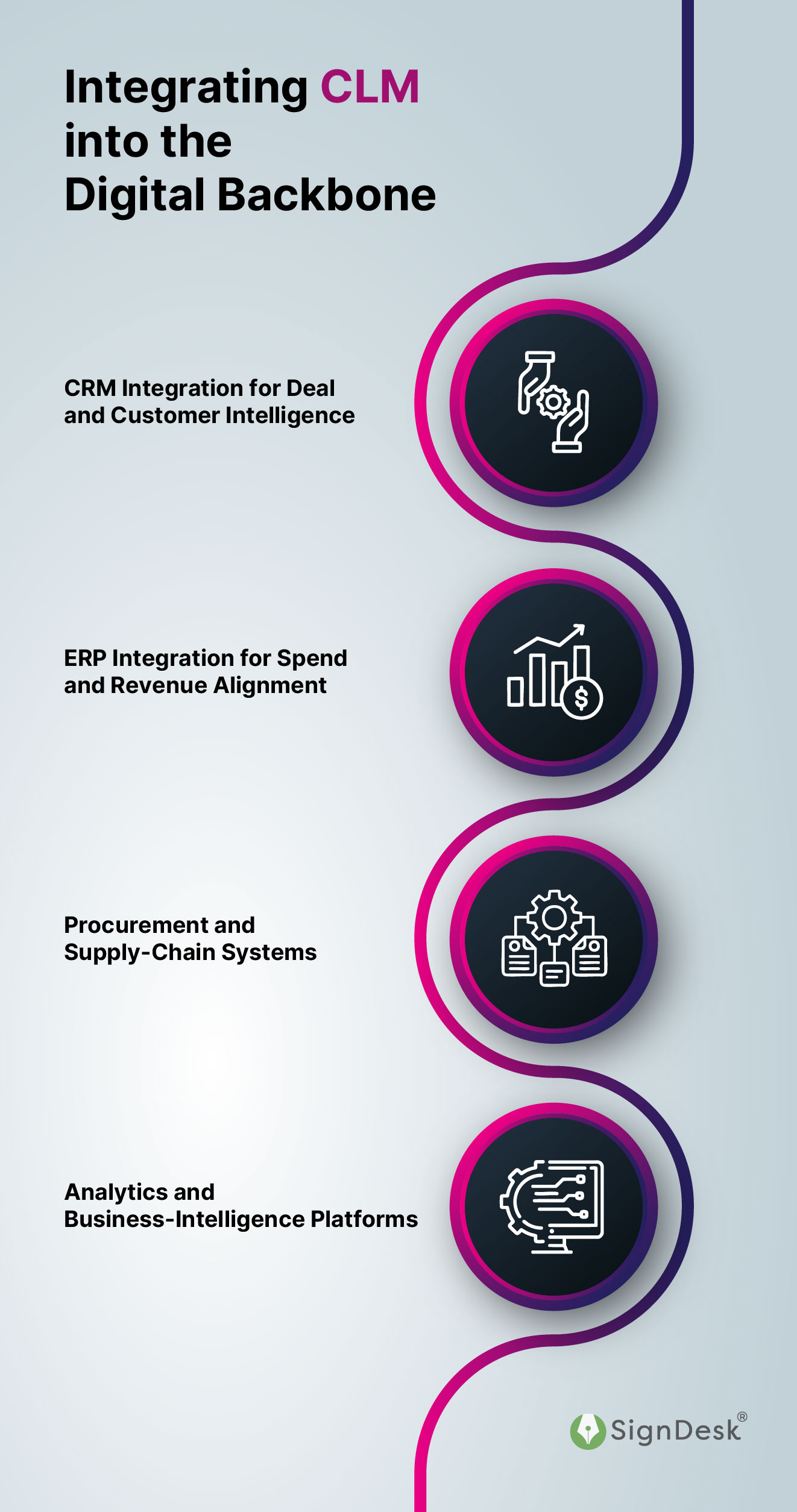Organizations navigating complex mergers and acquisitions (M&A), large-scale procurement, and stringent compliance regimes face a common challenge: disparate contract repositories, manual processes, and limited visibility slow decision making and introduce risk. A modern Contract Lifecycle Management (CLM) platform operates behind the scenes, bundling clause-level intelligence, automated workflows, and real-time dashboards to drive velocity across these critical functions.
When CLM becomes the connective layer across deal teams, procurement centers, and compliance functions, contracts evolve from static records to dynamic enablers of business agility.
Accelerating M&A with Contract Intelligence
Mergers and acquisitions rely on rapid, accurate due diligence. Legacy approaches, scanning PDFs, manually extracting key terms, and juggling disparate spreadsheets, delay deal closures and elevate risk. When acquiring or merging business units, leadership demands clarity on obligations, liabilities, and revenue streams embedded in thousands of contracts ranging from customer agreements to vendor SLAs.

Automated Contract Discovery and Classification
Rather than assigning teams to sift through shared drives, next-gen CLM software automatically ingest contract repositories and classify documents by type, value, expiration date, and risk profile.
SignDesk’s machine-learning engine scans over 10,000 agreements during a typical mid-market acquisition, categorizing each by counterparty, jurisdiction, and critical clauses; no manual tagging required. Legal and finance teams identify high-risk contracts within hours rather than weeks.
Clause-Level Risk Scoring
M&A advisors need to pinpoint indemnities, change-of-control provisions, termination triggers, and liability caps. CLM extracts these clauses into structured fields and applies risk scores based on predefined playbooks. For example, if a supplier contract lacks a change-of-control termination right, the platform flags it as high risk.
SignDesk clients routinely surface 95 percent of high-risk clauses within the first two days of diligence, enabling deal teams to negotiate protective amendments or price adjustments early in the process. This capability is powered by SignDesk’s advanced clause extraction and risk scoring modules, which automatically identify and prioritize contractual risks without manual intervention
Real-Time Portfolio Dashboards
When management asks for a consolidated view: “How many customer contracts have revenue thresholds below $1 million?” the CLM dashboard provides instant answers. Executives track total contract value by geography, revenue under management by product line, and renewal exposure across the portfolio. By visualizing clause distributions and liabilities, boards can evaluate synergies and liabilities with confidence.
SignDesk’s M&A clients report shaving 30 percent off typical due-diligence timelines, accelerating deal closings by an average of 45 days.
Automated Post-Merger Integration
After deal completion, integrating acquired contracts into a unified CLM repository enforces standardization. Counterparty data, payment terms, and service-level metrics flow into a single dashboard. Cross-functional teams, legal, finance, procurement, access a shared view to rationalize suppliers, align SLAs, and renegotiate terms under unified playbooks.
By embedding CLM at the heart of M&A, organizations reduce due-diligence costs, minimize surprises, and accelerate integration, enabling leadership to focus on growth rather than administrative drag.
Empowering Procurement to Operate at Scale
Procurement teams often manage thousands of supplier contracts across regions and categories. The complexity intensifies when sourcing for specialized components, onboarding new vendors, or renegotiating master service agreements. An effective CLM platform transforms these activities into streamlined, data-rich processes.
- Centralized Supplier Contract Repository: Procurement analysts access a single source of truth for all vendor agreements, searchable by keywords, spend category, or risk level.
- Automated Approval Workflows and KPI Tracking: When a buyer initiates a new supplier engagement, the CLM engine routes the draft to legal, finance, and compliance in parallel. SLA metrics, delivery timelines, quality thresholds, penalty structures, populate predefined dashboards. Procurement leadership tracks average “time-to-contract” metrics, identifies bottlenecks by department, and enforces service-level expectations.
- Dynamic Negotiation Analytics: Features such as “Most Negotiated Clauses” and “Average Negotiation Rounds” surface trends—if a specific indemnity clause triggers lengthy revisions in 60 percent of supplier deals, procurement and legal teams collaborate to develop alternative language that balances risk with commercial viability.
- Spend Visibility and Compliance Enforcement: CLM integrates with ERP systems to align actual spend with contract terms. When a supplier exceeds contracted volumes, the platform triggers alerts to procurement and finance for renegotiation or volume discounts. For regulated industries, CLM tracks supplier certifications, ISO 9001, ISO 27001, or minority-owned business status—ensuring compliance with internal diversity programs and external audit requirements. Clients leveraging SignDesk for procurement trace 95 percent of cumulative spend to active contracts, eliminating “rogue spend” and enforcing governance.
By embedding CLM within procurement processes, enterprises achieve faster supplier onboarding, tighter compliance, and deeper visibility into spend, all critical for scaling operations and mitigating supply-chain risk.
Embedding Compliance Across the Organization
Regulatory landscapes evolve quickly. Data-privacy rules shift, industry-specific mandates emerge, and geopolitical considerations reshape trade compliance. Organizations lack the luxury of reviewing every contract manually when regulations change. A robust CLM platform provides a proactive compliance framework.
- Automated Regulatory Clause Updates
Compliance teams maintain standardized clause libraries aligned with evolving rules, GDPR, PDPA, anti-bribery, export controls. When a new regulation emerges, CLM pushes updated templates and flags all contracts containing outdated clauses.
- Continuous Audit Trails
Auditors require an immutable record of every change, who approved it, when, and why. CLM’s version-control and digital-signature capabilities create timestamped logs. When regulators request evidence of compliance, management generates reports in minutes instead of days.
- Risk Scoring and Alerts
With clause-level analytics, CLM assigns risk scores to each agreement. Contracts missing key compliance language, such as anti-money-laundering provisions or environmental safeguards, receive high-risk tags. Real-time alerts notify responsible stakeholders, ensuring swift remediation.
- Cross-Functional Compliance Dashboards
Senior leaders monitor global compliance status via dashboards showing:
- Percentage of contracts containing required compliance clauses by jurisdiction
- Number of contracts pending amendment due to regulatory change
- Total potential exposure based on contract values and missing clauses
Armed with these insights, boards hold management accountable for timely risk mitigation.
Integrating CLM into the Digital Backbone
For CLM to act as an “invisible engine,” it must integrate with existing enterprise applications, CRM, ERP, procurement systems, and AI-driven analytics tools. Integration delivers seamless data flow and ensures that contract intelligence informs decision making across functions.

- CRM Integration for Deal and Customer Intelligence: When sales teams close deals in CRM platforms like Salesforce, CLM automatically generates contract drafts with negotiated terms. Key metrics, average discount rates, renewal terms, or transaction volumes, sync back to the CRM, refining pipeline forecasting and customer lifetime-value calculations.
- ERP Integration for Spend and Revenue Alignment: Contract terms, payment schedules, penalty clauses, and volume discounts, align with ERP-generated purchase orders and invoices. Finance teams avoid revenue-recognition errors and mitigate disputes.
- Procurement and Supply-Chain Systems: When procurement systems register supplier performance issues, missed deliveries, quality incidents, CLM cross-references related contract clauses (SLAs, penalty provisions) and triggers remediation workflows.
- Analytics and Business-Intelligence Platforms: Exporting contract-derived data to BI tools unlocks enterprise-wide insights. Dashboards show correlations between contract features and deal velocity, supplier performance metrics, or compliance breach frequency. By analyzing these trends, leadership prioritizes investments, adjusts risk tolerances, and aligns resource allocation with strategic objectives.
Through tight integration, CLM operates invisibly, contract intelligence flows behind the scenes, fueling M&A diligence, procurement optimization, and compliance assurance without manual handoffs.
Embracing CLM as a Non-Negotiable Foundation
Many leaders view CLM as a legal back-office application, useful but not central to strategic initiatives. Forward-looking organizations recognize that CLM must operate invisibly yet powerfully, knitting together functions that historically operate in silos. When M&A, procurement, and compliance share a single, intelligent contract backbone, leadership gains the ability to move faster, manage risk actively, and allocate resources with greater precision.
CLM no longer serves merely to store executed documents. Instead, it functions as a continuous source of intelligence: surfacing hidden liabilities during an acquisition, enforcing governance across global supply chains, and ensuring compliance with evolving regulations. By treating CLM as an invisible engine, fueling speed and insight behind the scenes, enterprises gain a durable competitive edge.
For CXOs tasked with orchestrating growth and mitigating risk, transforming CLM from a standalone tool into an invisible engine represents one of the most impactful strategic moves available today. When contracts cease to be static templates and instead become dynamic, intelligent assets, the entire enterprise moves at the speed of opportunity, building resilience today and preparing for tomorrow’s challenges.